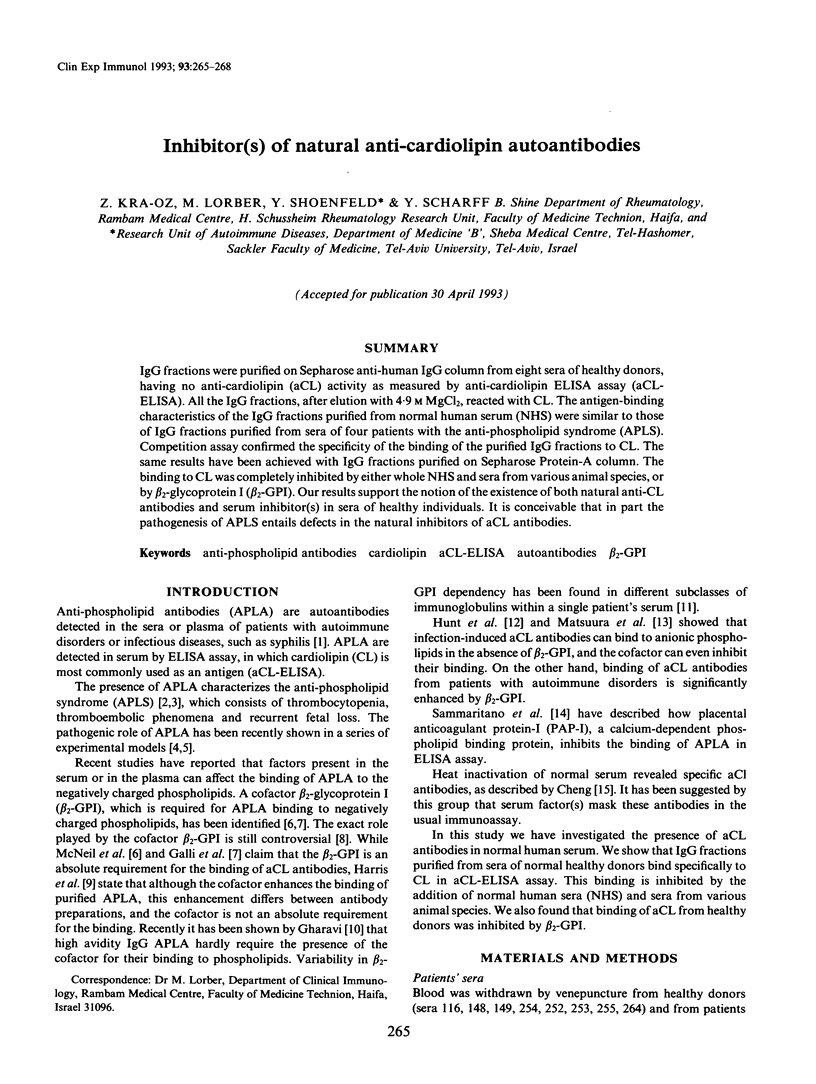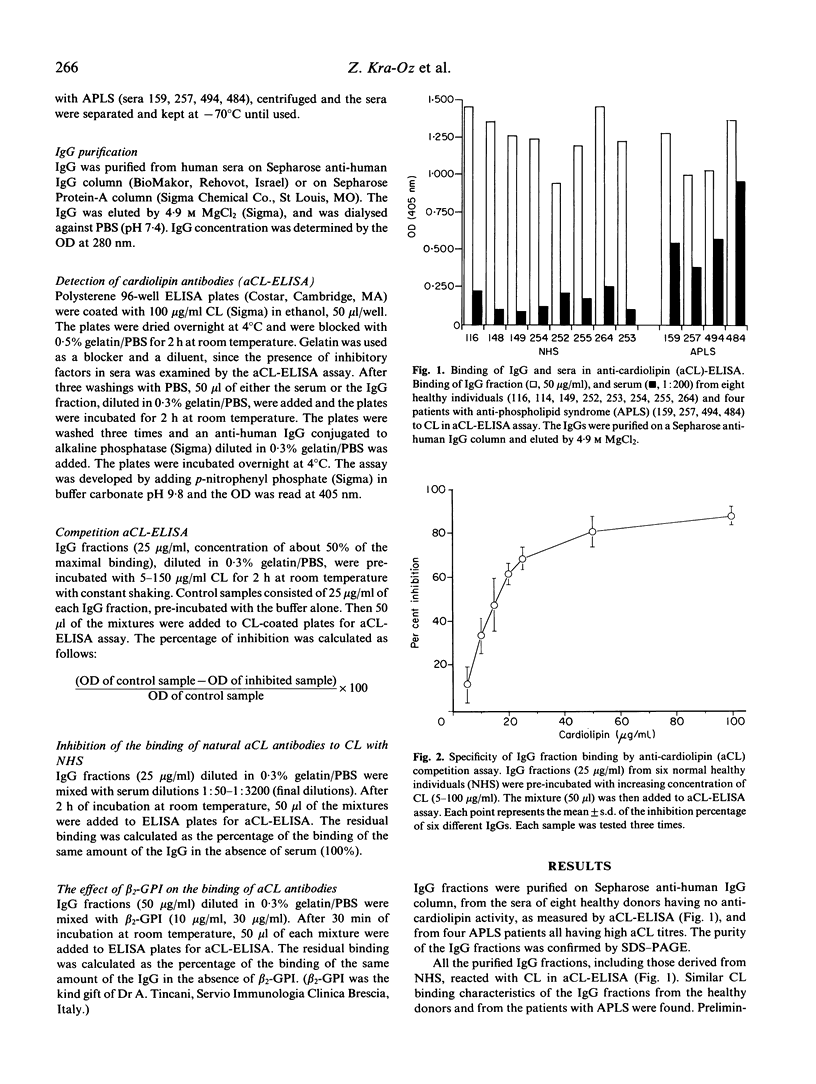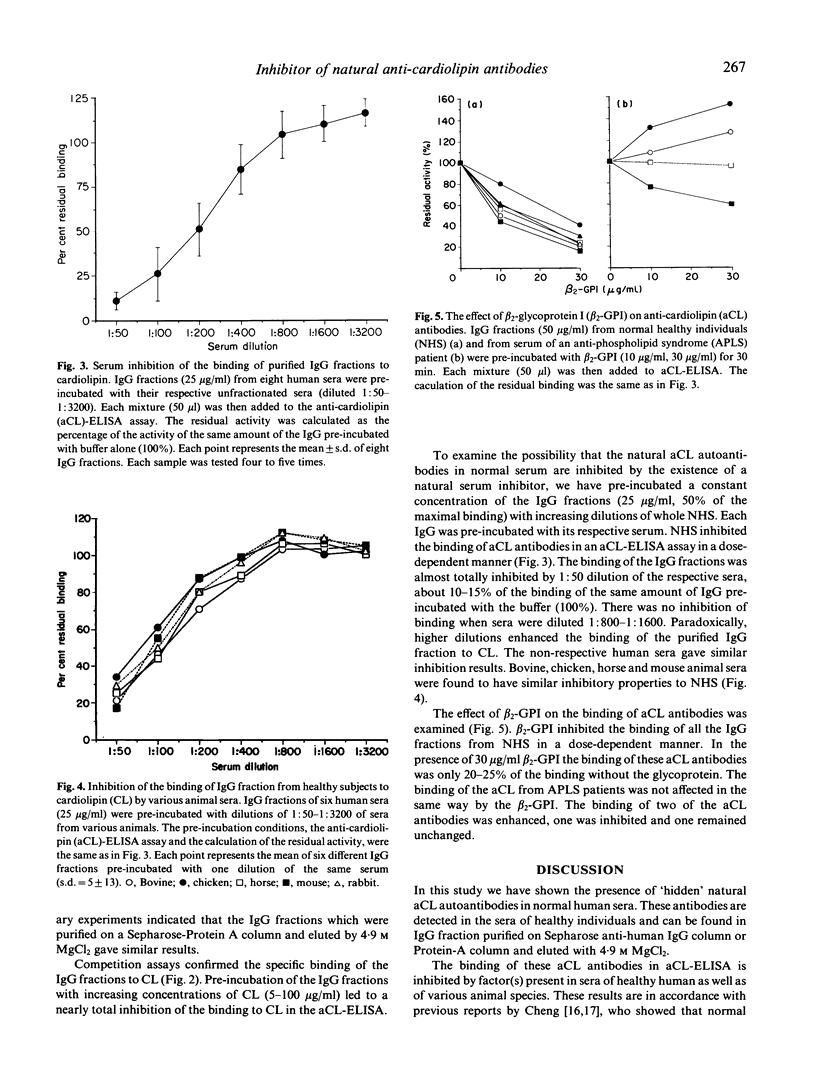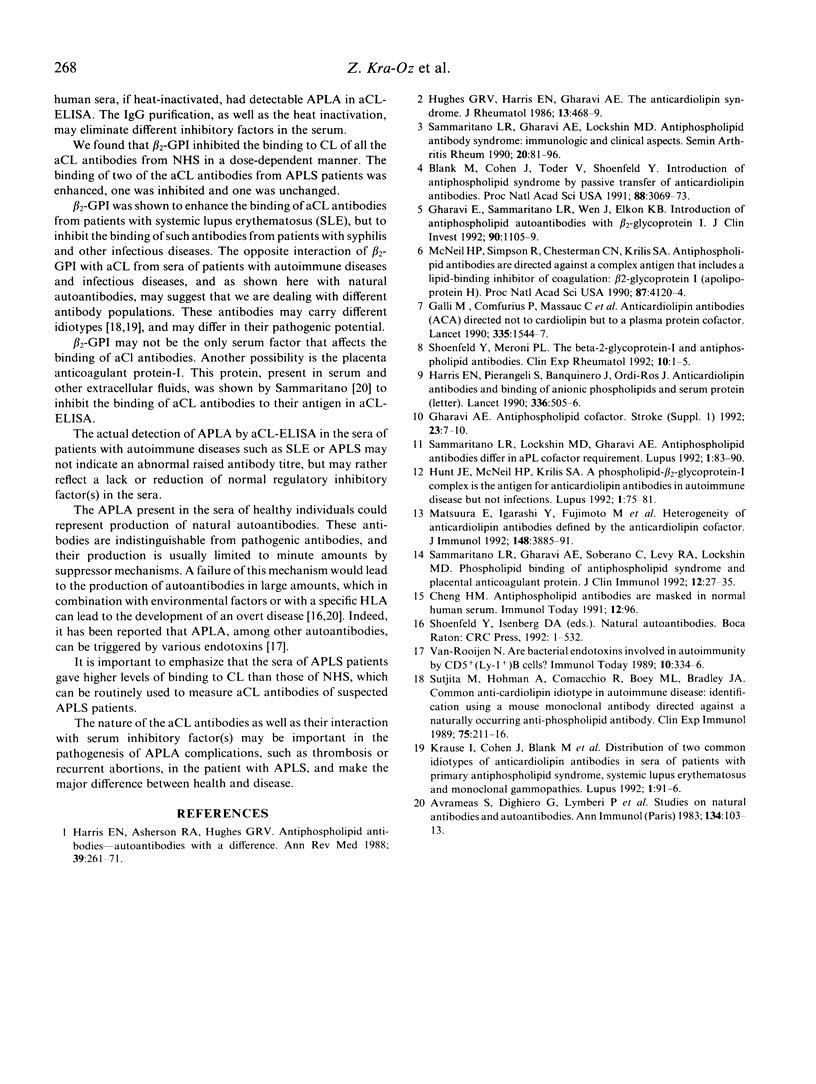Abstract
IgG fractions were purified on Sepharose anti-human IgG column from eight sera of healthy donors, having no anti-cardiolipin (aCL) activity as measured by anti-cardiolipin ELISA assay (aCL-ELISA). All the IgG fractions, after elution with 4.9 M MgCl2, reacted with CL. The antigen-binding characteristics of the IgG fractions purified from normal human serum (NHS) were similar to those of IgG fractions purified from sera of four patients with the anti-phospholipid syndrome (APLS). Competition assay confirmed the specificity of the binding of the purified IgG fractions to CL. The same results have been achieved with IgG fractions purified on Sepharose Protein-A column. The binding to CL was completely inhibited by either whole NHS and sera from various animal species, or by beta 2-glycoprotein I (beta 2-GPI). Our results support the notion of the existence of both natural anti-CL antibodies and serum inhibitor(s) in sera of healthy individuals. It is conceivable that in part the pathogenesis of APLS entails defects in the natural inhibitors of aCL antibodies.
Full text
PDF



Selected References
These references are in PubMed. This may not be the complete list of references from this article.
- Avrameas S., Dighiero G., Lymberi P., Guilbert B. Studies on natural antibodies and autoantibodies. Ann Immunol (Paris) 1983 Jul-Aug;134D(1):103–113. [PubMed] [Google Scholar]
- Blank M., Cohen J., Toder V., Shoenfeld Y. Induction of anti-phospholipid syndrome in naive mice with mouse lupus monoclonal and human polyclonal anti-cardiolipin antibodies. Proc Natl Acad Sci U S A. 1991 Apr 15;88(8):3069–3073. doi: 10.1073/pnas.88.8.3069. [DOI] [PMC free article] [PubMed] [Google Scholar]
- Cheng H. M. Antiphospholipid antibodies are masked in normal human serum. Immunol Today. 1991 Feb;12(2):96–96. doi: 10.1016/0167-5699(91)90169-T. [DOI] [PubMed] [Google Scholar]
- Galli M., Comfurius P., Maassen C., Hemker H. C., de Baets M. H., van Breda-Vriesman P. J., Barbui T., Zwaal R. F., Bevers E. M. Anticardiolipin antibodies (ACA) directed not to cardiolipin but to a plasma protein cofactor. Lancet. 1990 Jun 30;335(8705):1544–1547. doi: 10.1016/0140-6736(90)91374-j. [DOI] [PubMed] [Google Scholar]
- Gharavi A. E., Sammaritano L. R., Wen J., Elkon K. B. Induction of antiphospholipid autoantibodies by immunization with beta 2 glycoprotein I (apolipoprotein H). J Clin Invest. 1992 Sep;90(3):1105–1109. doi: 10.1172/JCI115927. [DOI] [PMC free article] [PubMed] [Google Scholar]
- Harris E. N., Asherson R. A., Hughes G. R. Antiphospholipid antibodies--autoantibodies with a difference. Annu Rev Med. 1988;39:261–271. doi: 10.1146/annurev.me.39.020188.001401. [DOI] [PubMed] [Google Scholar]
- Harris E. N., Pierangeli S., Barquinero J., Ordi-Ros J. Anticardiolipin antibodies and binding of anionic phospholipids and serum protein. Lancet. 1990 Aug 25;336(8713):505–506. doi: 10.1016/0140-6736(90)92053-k. [DOI] [PubMed] [Google Scholar]
- Hunt J. E., McNeil H. P., Morgan G. J., Crameri R. M., Krilis S. A. A phospholipid-beta 2-glycoprotein I complex is an antigen for anticardiolipin antibodies occurring in autoimmune disease but not with infection. Lupus. 1992 Feb;1(2):75–81. doi: 10.1177/096120339200100204. [DOI] [PubMed] [Google Scholar]
- Krause I., Cohen J., Blank M., Bakimer R., Cartman A., Hohmann A., Valesini G., Asherson R. A., Khamashta M. A., Hughes G. R. Distribution of two common idiotypes of anticardiolipin antibodies in sera of patients with primary antiphospholipid syndrome, systemic lupus erythematosus and monoclonal gammopathies. Lupus. 1992 Feb;1(2):91–96. doi: 10.1177/096120339200100206. [DOI] [PubMed] [Google Scholar]
- Matsuura E., Igarashi Y., Fujimoto M., Ichikawa K., Suzuki T., Sumida T., Yasuda T., Koike T. Heterogeneity of anticardiolipin antibodies defined by the anticardiolipin cofactor. J Immunol. 1992 Jun 15;148(12):3885–3891. [PubMed] [Google Scholar]
- McNeil H. P., Simpson R. J., Chesterman C. N., Krilis S. A. Anti-phospholipid antibodies are directed against a complex antigen that includes a lipid-binding inhibitor of coagulation: beta 2-glycoprotein I (apolipoprotein H). Proc Natl Acad Sci U S A. 1990 Jun;87(11):4120–4124. doi: 10.1073/pnas.87.11.4120. [DOI] [PMC free article] [PubMed] [Google Scholar]
- Sammaritano L. R., Gharavi A. E., Lockshin M. D. Antiphospholipid antibody syndrome: immunologic and clinical aspects. Semin Arthritis Rheum. 1990 Oct;20(2):81–96. doi: 10.1016/0049-0172(90)90021-7. [DOI] [PubMed] [Google Scholar]
- Sammaritano L. R., Gharavi A. E., Soberano C., Levy R. A., Lockshin M. D. Phospholipid binding of antiphospholipid antibodies and placental anticoagulant protein. J Clin Immunol. 1992 Jan;12(1):27–35. doi: 10.1007/BF00918270. [DOI] [PubMed] [Google Scholar]
- Sammaritano L. R., Lockshin M. D., Gharavi A. E. Antiphospholipid antibodies differ in aPL cofactor requirement. Lupus. 1992 Feb;1(2):83–90. doi: 10.1177/096120339200100205. [DOI] [PubMed] [Google Scholar]
- Stuckey B. G., Hanrahan P. S., Zilko P. J., Owen E. T. Hypogammaglobulinemia and lung infiltrates after gold therapy. J Rheumatol. 1986 Apr;13(2):468–469. [PubMed] [Google Scholar]
- Sutjita M., Hohmann A., Comacchio R., Boey M. L., Bradley J. A common anti-cardiolipin antibody idiotype in autoimmune disease: identification using a mouse monoclonal antibody directed against a naturally-occurring anti-phospholipid antibody. Clin Exp Immunol. 1989 Feb;75(2):211–216. [PMC free article] [PubMed] [Google Scholar]
- van Rooijen N. Are bacterial endotoxins involved in autoimmunity by CD5+ (Ly-1+) B cells? Immunol Today. 1989 Oct;10(10):334–336. doi: 10.1016/0167-5699(89)90189-8. [DOI] [PubMed] [Google Scholar]


